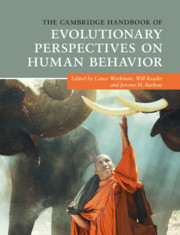Book contents
- The Cambridge Handbook of Evolutionary Perspectives on Human Behavior
- The Cambridge Handbook of Evolutionary Perspectives on Human Behavior
- Copyright page
- Dedication
- Contents
- Figures
- Tables
- Contributors
- Preface
- Acknowledgments
- Part I The Comparative Approach
- Part II Sociocultural Anthropology and Evolution
- Part III Evolution and Neuroscience
- Part IV Group Living
- 10 The Problem of Altruism and Future Directions
- 11 Can Evolutionary Processes Explain the Origins of Morality?
- 12 The Evolution and Function of Third-Party Moral Judgment
- 13 Evolution of the Human Family
- 14 The Parasite-Stress Theory of Cultural Values and Sociality
- 15 The Evolution of Pride and Shame
- 16 Thinking Outside the Head
- Part V Evolution and Cognition
- Part VI Evolution and Development
- Part VII Sexual Selection and Human Sex Differences
- Part VIII Abnormal Behavior and Evolutionary Psychopathology
- Part IX Applying Evolutionary Principles
- Part X Evolution and the Media
- Index
- References
15 - The Evolution of Pride and Shame
from Part IV - Group Living
Published online by Cambridge University Press: 02 March 2020
- The Cambridge Handbook of Evolutionary Perspectives on Human Behavior
- The Cambridge Handbook of Evolutionary Perspectives on Human Behavior
- Copyright page
- Dedication
- Contents
- Figures
- Tables
- Contributors
- Preface
- Acknowledgments
- Part I The Comparative Approach
- Part II Sociocultural Anthropology and Evolution
- Part III Evolution and Neuroscience
- Part IV Group Living
- 10 The Problem of Altruism and Future Directions
- 11 Can Evolutionary Processes Explain the Origins of Morality?
- 12 The Evolution and Function of Third-Party Moral Judgment
- 13 Evolution of the Human Family
- 14 The Parasite-Stress Theory of Cultural Values and Sociality
- 15 The Evolution of Pride and Shame
- 16 Thinking Outside the Head
- Part V Evolution and Cognition
- Part VI Evolution and Development
- Part VII Sexual Selection and Human Sex Differences
- Part VIII Abnormal Behavior and Evolutionary Psychopathology
- Part IX Applying Evolutionary Principles
- Part X Evolution and the Media
- Index
- References
Summary
What drives us to climb that highest mountain? And what do we subsequently feel when we realize we are extremely bad at mountain climbing and decide to fake an injury to get helicoptered back to base camp? The emotions that shape these events and our responses to them – pride and shame – play a central role in motivating and regulating many of people’s thoughts, feelings, and behaviors (Tangney & Tracy, 2012). These self-conscious emotions drive people to work hard to succeed (Stipek, 1995; Weiner, 1985) and to behave in moral and pro-social ways in their relationships (Baumeister, Stillwell, & Heatherton, 1994; Leith & Baumeister, 1998; Retzinger, 1987). Yet despite their centrality to psychological functioning, pride and shame did not receive the same attention from early emotion researchers as the so-called basic emotions, such as joy, fear, and sadness (Campos, 1995; Fischer & Tangney, 1995).
- Type
- Chapter
- Information
- Publisher: Cambridge University PressPrint publication year: 2020
References
- 7
- Cited by



